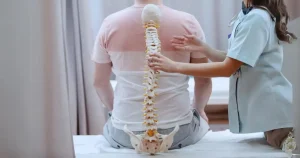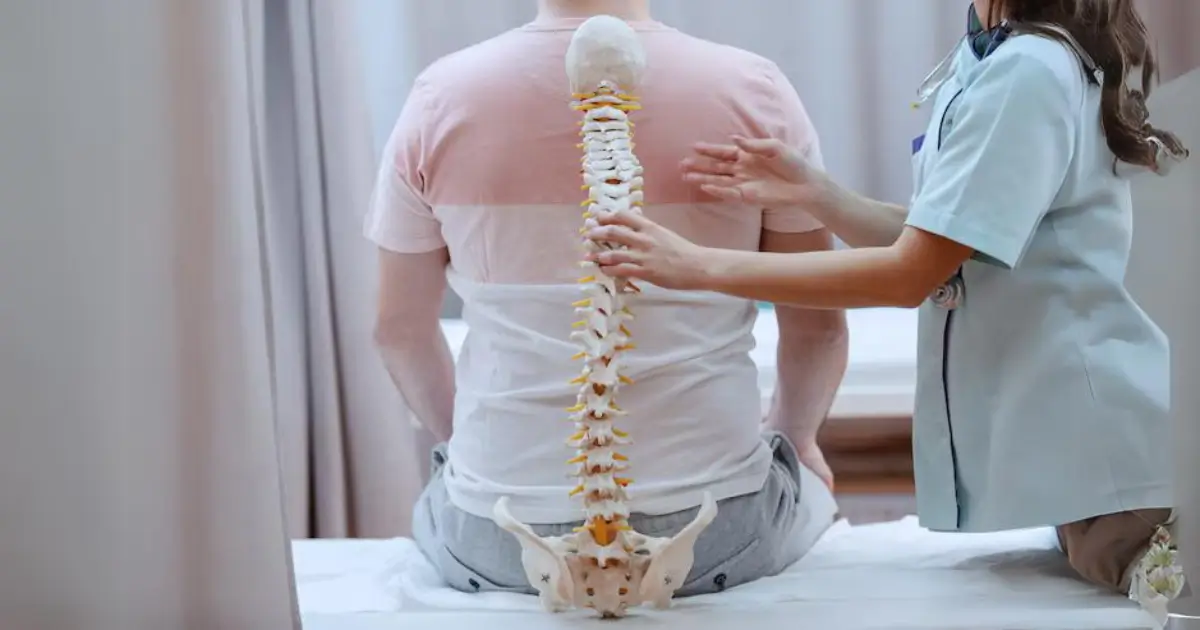
When it comes to spine health, the complicated relationship between physical pain, bad posture, and mental health can have a big effect on a person’s quality of life.
Learning about spinal degeneration, poor posture, and emotional pain can improve treatments like spinal manipulation and improve outcomes. Let’s examine these factors and see why spinal manipulation is better than drugs for relieving pain.
The Downward Spiral of Spinal Degeneration
Mechanical pain in the spine often stems from abnormal alignment and motion within the spinal column. It might put additional tension and pressure on nearby muscles, tendons, and connective tissue. When the body tries to adjust to these issues, it can lead to a cycle of inflammation, degeneration, and more pain.
Back problems that made it hard for the spine to move and connect properly are to blame for this mechanical pain. If your spine isn’t working well, it can cause problems like herniated discs or spinal stenosis due to stress and strain. In critical situations, these disorders may necessitate surgical remedies such as discectomy, removal of lamina, or fusion of the spine.
However, a non-surgical method seeks to treat the root causes of mechanical discomfort. Chiropractic spinal adjustment is an informal procedure for restoring correct spinal alignment and motion. It provides relief without the need for surgery.
The Origins of Chiropractic Care
Chiropractic originated in the late 19th century. The initial chiropractic adjustment was carried out by D.D. Palmer, and it’s worth noting the fascinating story behind it. Palmer’s first patient was the janitor in his office building. The janitor, Harvey, had suffered from hearing loss for decades following an injury where he heard a pop in his neck. Palmer reasoned that if he could find and reposition the misaligned vertebrae, he could help Harvey regain his hearing.
While this may seem far-fetched even to me, I recently had a remarkable experience with a patient named Ann. She recovered her hearing after just a couple of chiropractic appointments. Throughout my career, I have helped many patients with vision and other cognition-related issues, but Ann was my first patient to report regained hearing following chiropractic care.
The Chiropractic Motto
The chiropractic motto is, “Remove nerve interference, and the body will heal itself.” Nerve interference is caused by spinal kinks that pressure the central nervous system (CNS) and the spinal cord. These spinal kinks or misalignments are called subluxations or spinal lesions.
Linking Spinal Misalignments to Organ Health
Dr. Windsor’s groundbreaking study in 1921 revealed a strong correlation between spinal misalignments and organ health. In his research, Dr. Windsor examined 139 diseased organs, including the lungs, prostate, liver, gallbladder, heart, kidney, pancreas, stomach, spleen, bladder, and uterus. Remarkably, he found that 128 out of these 139 diseased organs showed minor curvatures or misalignments of the spine directly related to the affected area.
The remaining 10 suffering organs had comparable spinal abnormalities in the region slightly above or below the original location. Dr. Windsor proposed a mechanism for this connection: when a spinal segment is mal-positioned, it irritates the nearby sympathetic nerve ganglia, causing a vaso-motor spasm in the innervated organ. Over time, this reduced blood flow contributes to organ deterioration and disease.
The study suggests that correcting spinal alignment and maintaining proper spinal motion could prevent these issues, emphasizing the importance of maintaining a healthy spinal structure for overall health and longevity.
The Impact of Posture on Spinal Health and Beyond
Posture plays a crucial role in maintaining spinal health and overall well-being. Research shows that poor posture, such as forward head posture (FHP), can impact a person’s physical and emotional health.
Rene Cillet, from the University of California, San Diego, researched Forward Head Posture (FHP). The study found that FHP can decrease the body’s endorphin production. Endorphins are the human body’s discomfort relievers, and reducing them can significantly impact pain perception.
In 2004, a study found that older adults with more curvature in their mid-back have a higher mortality risk. It means that having a more curved mid-back could increase the chance of death. The form of someone’s mid-back may show how old they are and how long they will live.
The research emphasizes maintaining proper posture and back health as we age. This correlation highlights the importance of maintaining proper spinal alignment and posture throughout one’s lifespan.
The consequences of improper posture go beyond physical well-being. The British Regional Heart Study discovered a link between poor posture, height loss, and increased risk of heart disease. If you lose your height because of lousy balance, you may be more likely to get heart disease.
A research project by the British Regional Heart Study found this link. The study found that people with bad posture have a 64% higher chance of getting heart disease (1).
The Emotional Component of Pain
The old idea that pain is only physical has changed. Now, the biopsychosocial model of pain is more popular. This paradigm acknowledges that pain is a multifaceted experience shaped by psychological, social, and biological variables.
One of the critical emotional components of pain is the role of emotions and mental states. Research has shown that factors such as unhappiness at work can be the primary reason for recurrent pain episodes. Emotions can directly influence motor control, altering movement patterns and perpetuating the pain cycle.
This knowledge of the emotional aspect of pain has resulted in an expanded strategy for pain administration. Understanding and managing pain involves examining psychological, social, and physical factors that help individuals cope better.
Benefits of Spinal Manipulation for Pain Relief
Spinal manipulation therapy has emerged as a promising alternative to traditional pain medications for addressing spinal issues. Multiple investigations have shown that spinal manipulation effectively relieves pain and improves overall wellness.
Spine Journal found that spinal massage therapy works better than high-tech and low-tech workout plans. It makes the spine move better in just 12 weeks (2).
A 2012 report found that the effects of spinal manipulation are more effective for treating pain than opioids, aspirin, and ibuprofen. A study in 2012 found that chiropractic care and physical therapy were more effective than prescription medications. The benefits continued for a minimum of twelve months.
Moving your spine can change how muscles and nerves function, as shown in studies like the 2010 McMorland study.
The Findings on Spinal Manipulation
The research on the efficacy of spinal manipulation techniques for pain relief is compelling. Studies have consistently demonstrated the benefits of chiropractic adjustments in treating chronic neck pain and other spinal conditions.
A 2007 study found that manipulating the spine can work the multifidus muscle, an essential muscle that keeps the spine stable. Researchers discovered that one spinal manipulation session increased multifidus muscle thickness, showing better spinal nerve function and muscle recruitment (3).
Spinal manipulation works better than medicine for chronic neck discomfort. It has fewer side effects and provides better short- and long-term results. Patients who received spinal manipulation reported better outcomes and reduced disability compared to those who relied on pain medications.
Are you Suffering from Recurring Pain Due to Spinal Misalignment?
Book chiropractic sessions with us and get relief first hand!
Get AppointmentThe Final Words
Spinal manipulation has become known as a natural and very effective way to treat pain and improve general health. Numerous studies have demonstrated its superiority over traditional pain medications, showing better outcomes for chronic neck pain, reduced disability, and improved spinal function and muscle recruitment.
By addressing the root causes of mechanical discomfort, restoring proper spinal alignment, and considering the emotional components of pain, spinal manipulation offers a holistic solution with fewer side effects.
As research continues to highlight the intricate connections between physical pain, posture, emotional well-being, and even heart health, embracing spinal manipulation as a non-invasive alternative to drugs becomes increasingly compelling for individuals seeking long-term relief and enhanced quality of life.
REFERENCE
- Optimal Chiro. (2024, May 8). Heart disease – the silent killer. Retrieved from https://www.optimalchiro.ie/2017/06/heart-disease/
- Woodward, A. H. (2010). Letter to the Editor: Re: Furlan AD, Imamura M, Dryden T, et al. Massage for low back pain: An updated systematic review within the framework of the Cochrane Back Review Group. Spine, 35(7), 843-844. DOI: 10.1097/BRS.0b013e3181d2a7cf
- Pettingell, T. (n.d.). Needle EMG response of lumbar multifidus to manipulation in the presence of clinical instability. Retrieved from https://www.ncbi.nlm.nih.gov/pmc/articles/PMC2704352/

Meet Dr. Craig Eymann, a dedicated chiropractor and yoga enthusiast with over two decades of expertise in spinal health, sports chiropractic, and personalized care, prioritizing misalignment correction for swift injury resolution.
Categories
Tags
Recent Blogs




Leave A Comment